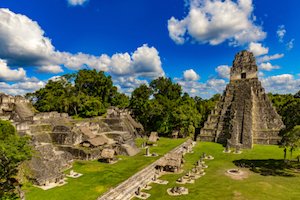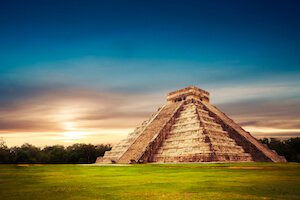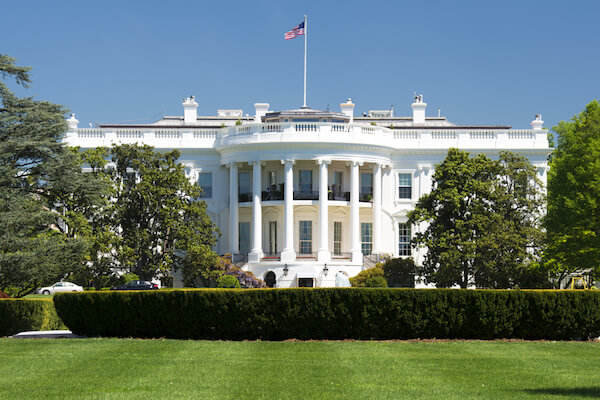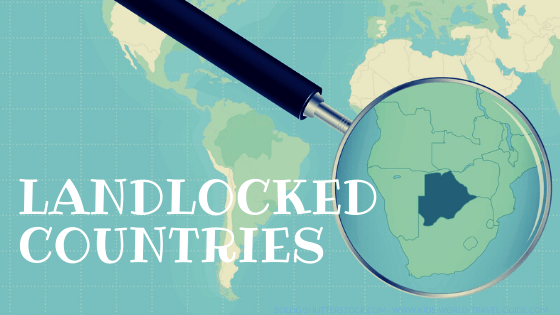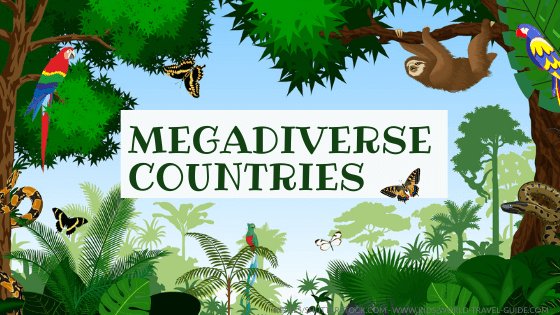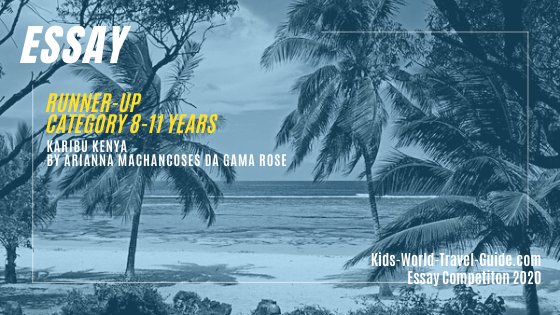- Homepage
- Barbados
Barbados Facts
Here are some interesting Barbados Facts which were chosen and researched by kids especially for kids.
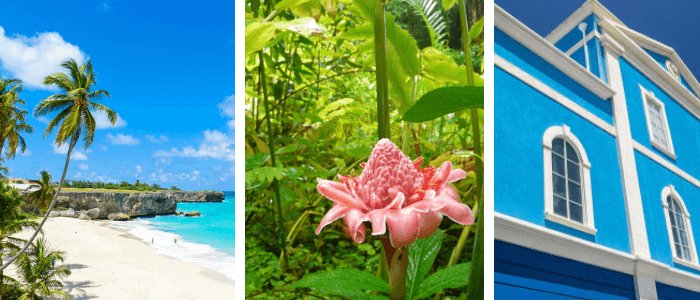
Interesting Barbados Facts
 Flag of Barbados
Flag of Barbados- Population: about 290,000 people live in Barbados (2023)
- Capital: Bridgetown with 100,000 inhabitants
- Government: republic with parliamentary democracy
- Language: English
- Literacy: 99% of all the Barbadians over the age of 15 years can read and write
- Religion: Christians (73%, with the vast majority being Protestants)
- Currency: 1 Barbados dollar = 100 cents
- National colors: blue, yellow, black
- National symbols: Neptune’s trident (shown also on the flag), pelican, Pride of Barbados (Red Bird of Paradise flower)
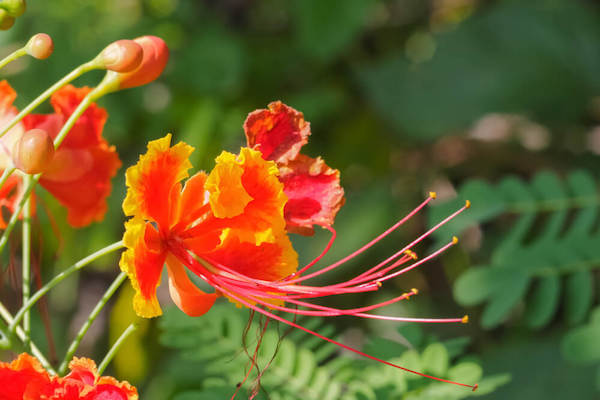 National Flower: Pride of Barbados
National Flower: Pride of Barbados- Independence Day: 30 November
- History: The first indigenous inhabitants on the island were Amerindians from Venezuela. The island was first claimed for the Spanish crown after Spanish explorers landed on the island in 1511. The Portuguese also set foot on the island on their route to Brazil in 1637. Barbados was colonised by the British who settled on the island in 1627. The first settlement was in the islands’ west and was called Holetown. The British cut down the dense rainforest and planted tobacco and cotton. They also introduced sugarcane and shipped slaves from Africa to make them work on their plantations. Slavery was abolished in 1834, but the island remained a British colony. Barbados reached independence from Britain in 1966 and now belongs to the Commonwealth States.
- Prime Minister: Mia Amor Mottley and President: Sandra Mason
Barbados Facts | Barbados Map
Barbados is located on the North American continent and is the easternmost island of the Caribbean islands and part of the Lesser Antilles.
The country lies northeast of Venezuela in the North Atlantic Ocean. Barbados is located close to the equator.

The island is tiny and its circumference is only about 100 km/ 70 miles and can be driven around in just three hours.
The country is roughly 2.5 times the size of the city of Washington D.C./ USA or three times the size of Liechtenstein.
 Barbados map
Barbados mapBarbados Facts | Geography
The island is mostly flat and there are some rolling hills in the centre of the island.
 Barbados aerial view
Barbados aerial view32% of the country is agricultural land. Before the island was populated by settlers, the island was covered in dense rainforest. Wild pigs roamed this rainforest.
Thick dense rainforest can still be found in the country’s interior.
 Barbadian rainforest
Barbadian rainforestMost of the country’s surface geology is made up of coral limestone.
The country's climate is tropical and the average daytime high is 30 degrees Celsius/86 degrees Fahrenheit. The sea temperature is around 25 degrees Celsius on average!
The dry season lasts from January to June. Hurricane season is from July to October. Barbados has around 3,000 sunshine hours per year.
Barbados Geography Superlatives
- Barbados is the easternmost Caribbean island
- This island country is one of the 20 smallest countries in the world. The island is just 34 km/ 21 miles long and up to 23 km/ 14 miles wide
- Barbados is the most densely populated country in the Caribbean, the fourth most populated country in the Americas and the 18th most densely populated country in the world
- The highest point is Mount Hillaby which is just 336 metres/ 1,100 ft. above sea level
- There are many underground lakes, but no lake on the surface!
- Barbados lies on the boundary of the South American and Caribbean tectonic plates. The island is composed of limestone and thick coral soil and the island is also circled by coral reefs.
Attractions in Barbados
Barbados is one of the Caribbean's most visited travel destinations due to its fine sandy beaches and colourful reefs. Among the most popular attractions are:
- Crane Beach: This beach often is called the most famous beach of the island. However, there are many more amazing beaches that can be explored as well.
 Beach paradise Barbados
Beach paradise Barbados- Bridgetown: The capital of Barbados has been an important port town for many centuries. The historic town with its British colonial architecture and military garrison will tell you about the country's history. An UNESCO heritage site since 2011, the colourful houses of the town are well preserved. The famous Chamberlain Bridge in the inner marina gave the town its name.
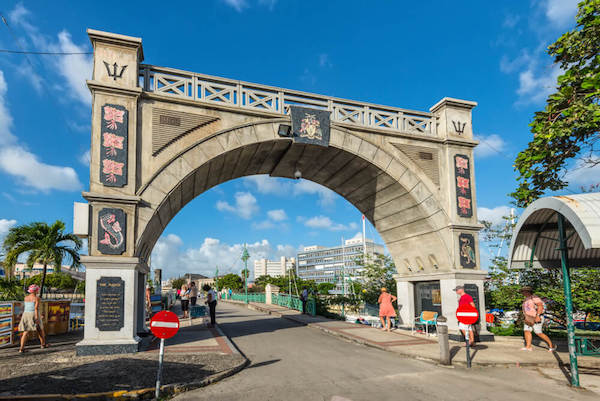 Bridgetown Independence Gate - image by Byvalet
Bridgetown Independence Gate - image by Byvalet- St. Nicholas Abbey: This historic site includes a sugar museum that tells about the island's past. Did you know that Barbados once had 500 sugar plantations? You can also visit the well-preserved Sunbury Plantation House, one of the oldest colonial plantation houses on the island.
 Sunbury Plantation House
Sunbury Plantation House- Morgan Lewis Mill: One of the oldest restored sugar mills of the island. The windmill stopped working in 1947 and is now a tourist attraction. The Barbados National Trust occasionally opens the mill for sugar cane grinding demonstrations.
 Morgan Lewis Mill - image by Simon Dannhauer
Morgan Lewis Mill - image by Simon Dannhauer- Harrison’s Cave: This cave is known for its crystal clear water. The cave system is more than 2.3km/ 1.4 miles long while the largest cave hall is 15m/ 49ft high.
 Harrisons Cave
Harrisons CaveBarbados Facts
Barbados People
The people living in Barbados are called Barbadians or Bajans. English is the official language, but the locals communicate in an English creole language called Bajan.
 Barbadian postman - image by Stephanie Braconnier
Barbadian postman - image by Stephanie BraconnierMost Barbadians are of Afro-Caribbean or mixed descent.
Bridgetown is the biggest city of the island. One third of the population live in the island’s biggest towns such as Bridgetown, Speightstown or Holetown.
All children must attend school until the age of 16 years.
 Bridgetown city centre - image by Solarisys
Bridgetown city centre - image by SolarisysCricket is considered the national sport. Several Barbadians play in the cricket team of the West Indies. The most famous cricket ground in Barbados is the 'Kensington' Oval. The Cricket World Cup was held in Barbados in 2007. Rugby, volleyball, netball, soccer and basketball are also popular among locals.
The biggest cultural event of the year is the Crop Over festival, that includes a carnival and calypso music that is typical for the island.
The parliament of Barbados is the third oldest in the world, dating back to 1639.
 Parliament Buildings
Parliament BuildingsBarbados has the wealthiest population in the Eastern Caribbean. However, more people leave the island than immigrate. The population growth rate is very low.
Please note that it is illegal to wear any form of camouflage dress in Barbados.
Barbados Facts | Barbados Animals
Barbados’ main ecosystems are the marine and coastal ecosystems. Barbados is home to four species of turtles such as green turtles, loggerhead turtles as well as hawksbills and leatherback turtles.
Land animals also include bats, lizards and green monkeys.
 Barbados Green Monkeys - Image by Gemma Ribakovs
Barbados Green Monkeys - Image by Gemma RibakovsThere are 270 bird species living in Barbados, but just one is endemic, that means this species can only be found on this island. This is the Barbados bullfinch.
Most animals on the island were introduced by humans.
More Barbados Facts:
Barbados Economy
The main industries are tourism, sugar production and light manufacturing. Natural resources include petroleum, natural gas and fish. The most important agricultural products are vegetables, cotton and sugar cane.
The biggest import and export partners are the USA, Trinidad and Tobago and China. Barbados exports mainly sugar, molasses, rum and manufactured goods.
 Barbados roadside - image by Simon Dannhauer
Barbados roadside - image by Simon DannhauerBarbados Food
A traditional Bajan meal includes meat (mainly chicken or pork) or fish, that has been marinated in herbs and spices, a starchy side dish such as sweet potatoes and some spicy gravy, as well as salad and fruits.
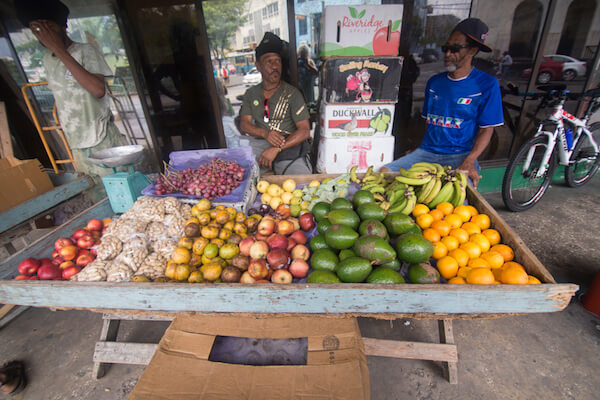 Fruits at the market - image by Ana del Castillo
Fruits at the market - image by Ana del CastilloBarbadian cooking is typically a mix of African and European (Portuguese, French, English) food traditions. The dishes usually have mixed influence, such as 'fish and chips' which also have a unique taste, as they have a strong local influence due to the spice mix batter and the use of different herbs.
The national dish is Cou-Cou and flying fish. Flying fish is a small fish species which is abundant in Barbadian waters.
 Flying Fish sandwich with fries
Flying Fish sandwich with friesTypical food in Barbados:
- Flying fish sandwich: Seasoned flying fish dipped in a spicy cajun batter, then grilled or deep fried, usually served with French fries or macaroni pie and some salad or coleslaw
- Cou cou: Cornmeal stew with okra. This dish has a strong African influence. In the Westafrican country of Ghana, people have a very similar maize flour dish which is traditionally stirred while cooking with a flat wooden stick.
- Pudding and Souse: Pickled pork with spiced sweet potatoes
- Macaroni pie: Baked macaroni and cheese dish, usually spiced with curry powder or other spices and served as a side dish with fried fish
- Conkies: Corn cookies made with sweet potatoes or coconut flour and wrapped in banana leaf
Did you know that…?
- The Portugues sailors named the island ‘Los Barbados’ meaning ‘bearded ones’ because of the fig trees of the island that have beard-like hanging roots!
- Award-winning sinner Rihanna was born in Barbados in 1988.
Barbados Facts - Reading and Resources
- Central Intelligence Agency. "Barbados." World Fact Book. 25 September 2023. Last accessed 29 September 2023
- Visit Barbados. "Unesco Heritage Site." Barbados Tourism Marketing. Last accessed 29 September 2023
- Go Barbados. "Discover Barbados." Barbados Tourism Encyclopaedia. Last accessed 29 September 2023
- Kylie Morrow. "How to make flying fish and cou cou." Sandals.com. 5 July 2018. Last accessed 29 September 2023
- Go Barbados. "Conkies." Barbados Tourism Encyclopaedia. Last accessed 29 September 2023
- Alexandra Baradi. "21 Interesting Facts and Funfacts about Barbados." Travel with Bender. Last accessed 29 September 2023
Picture credits on Barbados Facts: own or shutterstock.com - see credits as captions under images
Return from Barbados Facts to Kids-World-Travel-Guide Homepage
Competition 2024 is open!

Countries in
North America
Do you like this page?

|
Would you like a link to share the information with your friends, fans and readers? Copy and paste onto your website, blog or Facebook page <a href="https://www.kids-world-travel-guide.com/barbados-facts.html">Kids World Travel Guide: Barbados Facts for Kids</a> Enjoy learning about the world! Happy Travelling! |
Like us
Competition 2024








